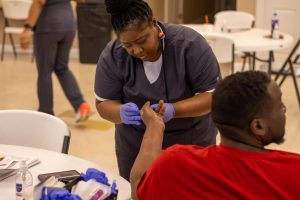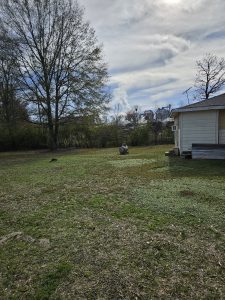Africatown, USA and Plateau is located in the north end of Mobile, Alabama.
It has been in existence since the enslaved Africans were emancipated in 1865 and settled in that area together. It is unique in many ways, including the fact that it was founded by African people immediately after the Civil War and continued to exist throughout the lifetime of its inhabitants as a community.
It is unique in that its inhabitants had a common story to tell that connected them directly to life in West Africa, to the process of being sold into slavery and transported to the U.S., to experiencing the process of being sold on the market in America, to working on plantations, and finally to being able to establish their own school, churches, and government as a community.
The story is recorded on films, maps, documents, and other artifacts in the Clotilda Exhibit. It is further illuminated by the existence of the Old Plateau Cemetery, the Omotunde Mural, the Africatown Mural, Gumpa’s Chimney, and the renovated school and churches in the vicinity. Although the tour of the facilities is a self-guided tour, with the assistance provided and sufficient time on hand, one can become quite well informed on the subject.
The Clotilda Exhibit is impressive also because much of what is presented is done so through the words and even the voices of the Africans who lived through the ordeals described. They speak directly on what they had witnessed or experienced, their culture in West Africa, the cruelties of slavery and the slave trade, the emotions that were generated as they journeyed through it all, and the work in which they engaged. There are accounts of how families were separated and how the elderly and sick were not purchased but left to die. There is also an accurate description of the hold of the ship on which they were transported across the ocean (500 square feet, 6 feet high with no windows for fresh air). They often lay or sat in cramped spaces for hours at a time, making it impossible for some to stand on their own when they were supposed to exercise and often in one another’s sweat and waste.
The exhibit comments not only on the fact that more than 12 million Africans were forcibly brought to the Americas, but that the resultant drastic loss of males in Africa led to the collapse of many African countries. This opened the doors to even more colonialism and imperialistic exploitation towards the people and the land. The enslavers’ disregard for the African institutions of marriage and the family – which had an immediate and long-term negative effect on those brought to America – is also highlighted in the exhibit.
Furthermore, it discusses the manner in which Africans were sold in the area of Dahomey and elsewhere. It also describes the barracoons, in which the captives were kept until they were shipped across the Atlantic. In the barracoons, the African captives developed communities, sometimes bonding in ways that helped them comfort one another or even stage rebellions onboard the ships once the voyages got started. Such rebellions, as well as the resistance and resilience of the enslaved Africans after emancipation, illustrate that the captive Africans were not docile and did not willingly accept their fate.
Many people may have heard of how Africans were forbidden to speak their languages or practice their native religions once they were enslaved. That is true and Africatown delves into the tactics that were used to enforce this. Enslaved Africans were humiliated by being “inspected” naked and made to take off and leave their African clothes behind as they were sold in America. There are personal accounts of how plantation owners often indiscriminately “paired” males and females for the sole and expressed purpose of mating to produce “enslaved” off-spring. There are accounts of how some enslaved Africans dreamed of and longed to return to Africa.
On the other side of the ledger, the exhibit makes it clear that the entire ordeal, which includes outfitting the Clotilda and buying the Africans who eventually constituted Africatown, was illegal. The American federal government had forbidden the importation of Africans since 1808. The Clotilda had sailed into the port near Mobile as late as 1859, 51 years later. Because the ship had been burned and sank beneath the sea after the importing of the Africans, the criminals – John Dabney, Timothy Meaher, Byrnes Maeher, and their conspirators – went unpunished for the crime of importing the Africans as slaves. (The 110 Africans had been sold in lots of 8, 16, 20, and more to local plantation owners and some to plantation owners in distant locations.) The white criminals had flaunted the law and made their money, with many newspapers reporting the crime shortly after the ordeal. It took 160 years for the evidence of the crime, the sunken Clotilda, to be discovered, proving that the importation had taken place.
Fortunately, slavery was abolished within five years of the Clotilda’s arrival. Once it was abolished, several African families remained on local plantations working as sharecroppers. Many others, however, moved into Mobile and other towns. In the towns, they found work, saved their money, and bought land in close proximity to one another, forming Africatown.
In this effort, one can be inspired by the manner in which these freed Africans helped one another build houses, how they supported the businesses of other Africans, and how they immediately established a Mobile County Training School. They organized three Baptist churches and a Catholic church. Then, they set up a local government with Gumpa as their chief and Ossa Keeby and Jaba Shade as judges. This was clearly a new and better American beginning than had been the case when they embarked from the Clotilda as enslaved West Africans.
A visit to Africatown is an excellent point of departure for a study of the African American story because it provides a clear undisputed connection to Africa and the nature of life on the continent of Africa. It shows how the Trans-Atlantic Slave Trade helped un-develop Africa while it provided for America’s tremendous economic growth. It shows what life was like among freed Africans before the horrors of Jim Crow and lynchings, before the emerging of the Civil Rights Movement, and before the dreaded racial backlashes under Richard Nixon, Ronald Reagan, Donald Trump, et. al.
From Africatown, one can, with even greater perspective, proceed to see the several African American historical museums and civil rights trail markers around the state of Mississippi, such as Holly Springs’ Ida B. Wells Museum, Mound Bayou’s Museum of African American Culture and History, Glendora’s Emmett Till Historic Intrepid Center (ETHIC), Natchez’s Museum of African American History and Culture, the various Black college museums, Canton’s Freedom House Museum, Hattiesburg’s African American Military History Museum, Jackson’s Smith Robertson Museum, and Mississippi’s Civil Rights Museum. They all highlight the African American story, confirming the validity of such significant works as CRITICAL RACE THEORY, PROJECT 1619, THE MIS-EDUCATION OF THE NEGRO, and CASTE: THE ORIGINS OF OUR DISCONTENTS.
Africatown opens the door and shows the Africans’ genius. It shows the creativity, the resourcefulness, the resistance, and the resilience that they had, which today can propel the descendants of these African people to the level where they should be today.







